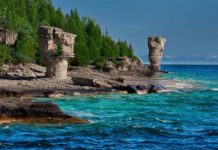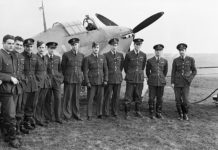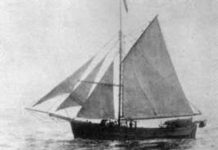James Bay is in sight! Land ho! The 1668 expedition to Canada’s north by explorers Groseilliers and Radisson was a success. It led to a Charter for HBC.
Two sturdy masts stood straight and tall on the Nonsuch, with the sails extending their grasp on the wind. Captain Zachariah Gillam plotted the ketch’s course across the Atlantic for the distant Hudson’s Bay, with French explorer Médard Chouart, Sieur des Groseilliers aboard ship. Alongside was the Eaglet, another ketch carrying another French explorer, Pierre-Esprit Radisson. Organized by a group of businessmen and royalty in London, England, the mission was to confirm the prospects of North America proposed by explorers Radisson and des Groseilliers, to open a fur-trading route through Hudson’s Bay. Funded partly by Prince Rupert and arranged by King Charles II, the ships set sail on June 3, 1668.
The ‘Nonsuch’ Prepared for Ocean Voyage
The Nonsuch was a small ship, not particularly suited for a long ocean voyage. At 53 feet long, the ketch had a narrow beam of 15 feet and a draft of 6 ½ feet. It had a displacement of 43 tons. The ketch had a crew of 12 to 13 men for the voyage. Built in 1850, it was originally used as a merchant vessel, then was purchased by the Royal Navy to use as a warship. Ready for battle, the Nonsuch carried a crew of 24 soldiers and was armed with cannons. The Gillam group purchased the ship for £290 in 1668 for their transatlantic excursion.
Radisson and des Groseilliers were Experienced Adventurers
Outfitted and ready to sail by May, the Nonsuch and the Eaglet “were full to bursting with foodstuffs, rope, clothing, guns, powder and shot, paper, quills and ink tools,” said Hudson’s Bay Company’s “Our History: Transportation and Technology.” The ships were also carrying items to trade with the natives, said HBC, such as “kettles, metal tools, needles, beads, tobacco and blankets.” On past trips, Radisson and des Groseilliers explored the east coast of North America, and inland as far as Hudson Strait.
Twelve hundred miles into the voyage, the Nonsuch and Eaglet sailed into violent, disastrous storms. Captained by William Stannard of the Royal Navy, the smaller ship was forced to turn back and return to England in August 1668. With Gillam at the helm of the Nonsuch, the ship continued westward to North America to complete the assigned expedition.
The Small ‘Nonsuch’ Pulled Ashore by Crew
On September 29th, the ship weighed anchor at their destination at the southern end of James Bay on the Rupert River. The adventurers spent 118 days on the ocean. With the Nonsuch’s handy small size, “the crewmen were able to easily haul the Nonsuch up out of the water, where the ice of winter would have surely crushed the hull of a larger vessel, no matter how stout her hull,” said John Burnett’s article, “A Ship from History,” on The British North America Philatelic Society site. Their ship safe, the crew built a winter camp, including a stockade and house called Charles Fort. (Charles Fort was later called Rupert House, used as a trading base by the Hudson’s Bay Company.
Des Groseilliers and Gillam “established friendly relations on the coasts of Hudson Bay with the Indians,” according to G. Andrews Moriarty. Gilliam “made a ‘treaty’ with the Indians by which he ‘purchased’ the Rupert River and the surrounding land; and he and des Groseilliers secured a cargo of fine beaver pelts which realized over £1,300.” The expedition a success, the voyageurs returned to England, the Nonsuch setting sail on June 14, 1669. Gillam, des Groseilliers and crew reached London in October.
Hudson Bay Company Incorporated 1670
The English were pleased with the results of the exploration and granted a Charter to the expedition company. The company eventually became the Hudson’s Bay Company, incorporated on May 2, 1670. Gillam and des Groseilliers set sail again for North America in the same month.
Zachariah Gillam was born in Boston, Massachusetts on July 30, 1636. Married three times, he had two sons. A seaman all his life, Gillam was lost at sea with his crew of approximately nine when the ship Prince Rupert was caught in a vicious storm and drifted out to sea. His death was recorded to be October 21, 1682.
A replica of the Nonsuch was built in Devon, England in 1968 for the 300th Anniversary celebration of the Hudson Bay Company in 1970, and shipped to Canada. After touring the country, the vessel was placed on permanent display at the Manitoba Museum in Winnipeg, Manitoba. Canada Post commemorated the historic voyage of the Nonsuch with a beautiful etched postage stamp, issued in 1968.







